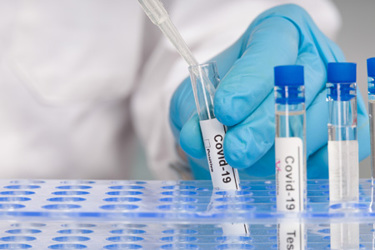Employing Wastewater Testing To Monitor Infection Trends And Control The Spread Of COVID-19
By Aaron Peacock, PhD

Since March of last year, when the World Health Organization (WHO) declared COVID-19 a global pandemic, the U.S. has recorded over 33.7 million cases of infection and surpassed 600,000 deaths due to the highly transmissible viral disease.
At its most unnerving height, the debilitating socioeconomic impact of the pandemic reverberated throughout the nation with unemployment figures reaching historic levels of the Great Depression in the 1930s. Small towns and large cities alike were transformed into ghost towns virtually overnight due to sweeping lockdowns that were designed to bring infection rates of SARS-CoV-2, the virus that causes COVID-19, under control.
Today, with the widespread availability of authorized COVID-19 vaccines, the U.S. has returned to a certain sense of normalcy in most parts of the country. Recently, however, WHO and other international public health groups have expressed pointed concern over the emergence of SARS-CoV-2 variants or mutants that have been responsible for new outbreaks in different parts of the globe.
Rapid Mobilization
Researchers and public health officials are rapidly mobilizing novel strategies, measures, and approaches to control the spread of COVID-19. One such approach entails using community wastewater (sewage) to measure the prevalence of SARS-CoV-2 in a given population.
Commonly referred to as wastewater-based epidemiology (WBE) or sewer surveillance, the method monitors community level infection trends by analyzing SARS-CoV-2 through various chemical or biological markers in wastewater entering treatment plants or within the collection system. Previously, WBE has been used in other infectious disease investigations (e.g., polio outbreaks).
Like most infectious diseases, SARS-CoV-2 can be shed in the stool of infected persons, including asymptomatic individuals. Regular testing of wastewater can capture infection spikes and precipitate individual testing. According to various estimates, SARS-CoV-2 can be detected in human feces anywhere from four to 10 days before the onset of symptoms, giving public health officials time to contain the spread of COVID-19 while the individual is still asymptomatic.
In a relatively short period of time, WBE has become a reliable, real-time surveillance tool for COVID-19 in nursing homes, workplaces, penitentiaries, public schools, senior citizen complexes, colleges and universities, and other community institutions.
Case In Point
As part of a project commissioned the Indiana Finance Authority (IFA), Microbac Laboratories, Inc. played an integral role in a large-scale study investigating the utility of a WBE approach. Fourteen Indiana communities with college or university campuses were among the participants in the study, which officially began in August 2020. Populations in the participating communities, which included Bloomington and Muncie, range from 2,700 to 101,000, although this number fluctuates during active school semesters. Bloomington and Muncie are home to two of the state’s largest universities, Indiana University and Ball State University, respectively.
For the purpose of the investigation, communities with colleges or university campuses were preferred due to the mobile nature of the student bodies during the pandemic. All of the wastewater utilities collected samples from the influent at wastewater treatment plants and from locations, such as lift stations or manholes, in different areas of the sewershed.
Most of the wastewater utilities where colleges and universities were located took samples representative of on-campus housing, off-campus housing, and downstream of the entire campus. Other treatment facilities focused on non-campus communities, such as nursing homes, prisons, and low-income housing units. Over the 90 day study, utilities collected over 1,900 samples from 15 wastewater treatment plants and 44 sites within the collection system.
Analytical testing, utilizing state-of-the-art polymerase chain reaction (PCR) technology, was conducted by private and independent laboratories in an effort to gauge viral prevalence in the participating Indiana communities.
In a published report entitled “Indiana Wastewater Monitoring Program: Sampling Community Sewersheds for SARS-CoV-2,” the IFA released a number of key findings from the study. Specifically, the researchers found:
- An interlaboratory comparison indicated consistent and reliable results between labs for this type of analysis;
- Temporal trends in wastewater were detectable in communities and college campuses and these trends mirrored trends in case data in most communities;
- Trends in wastewater samples and case data appeared to occur at the same time, but it is possible that signals in wastewater could serve as leading indicators in real-time practice if a community is experiencing severe delays or shortages in testing.
The findings also suggest that wastewater monitoring is especially valuable for locating hotspots at the building or neighborhood level, identifying trends in conjunction with viral testing results, and monitoring for new outbreaks as vaccines are deployed and case rates decrease.
All Things Considered
Growing numbers of cities and states in the U.S. are conveying great interest in WBE. In addition to monitoring populations at scale at a low cost, the health and environmental data provided by wastewater testing allows community leaders to get ahead the virus. This strategy, as underscored in the IFA study, is worthy of consideration by public health officials across the country.
 Dr. Aaron Peacock, Director of Molecular Biology at Microbac Laboratories, is an environmental scientist with 25 years of experience specializing in microbial molecular diagnostics. He has worked extensively in the development, evaluation and implementation of new technologies for molecular-based surveillance and forensics.
Dr. Aaron Peacock, Director of Molecular Biology at Microbac Laboratories, is an environmental scientist with 25 years of experience specializing in microbial molecular diagnostics. He has worked extensively in the development, evaluation and implementation of new technologies for molecular-based surveillance and forensics.
